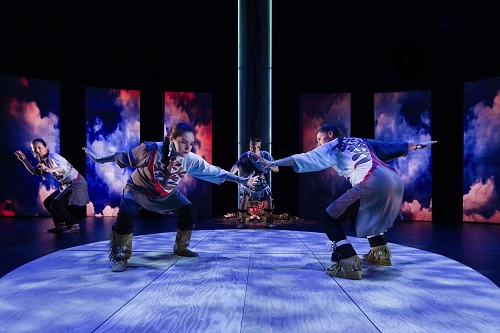 Themes of imbalance and renewal characterize Dancers of Damelahamid’s Mînowin
Themes of imbalance and renewal characterize Dancers of Damelahamid’s Mînowin
Dancers of Damelahamid’s new work, Mînowin, is a mesmerizing session of song and dance about reconnecting with ancestral Indigenous knowledge, easing the struggles of Indigenous people, and exploring how progress is a continuous process of imbalance and renewal. Staged in the cozy Harbourfront Centre Theatre, this DanceWorks production flirts with epic themes in the most intimate of spaces.
Mînowin translates to ‘the act of clarifying direction’, which is right in line with the company’s reason for being. According to Margaret Grenier, Executive and Artistic Director for the Dancers of Damelahamid, “I treasure dance as the most significant inheritance I have from my ancestors. For myself, dance, song, and story have provided a protective environment to address the limitations placed on our Indigenous peoples and to create a healing space”. In other words, the company’s articulated direction, the best way to go about its life, is to continue their peoples’ long lineage of reflecting experience and tradition through art.
Dancers of Damelahamid have been restoring traditional Indigenous songs and dances for over 50 years. That history continues here with a series of dances based on teachings from the Gitxsan people, a matrilineal society from the Northwest coast of British Columbia, from which the company also hails. Gitxsan translates to ‘people of the river of mist’.
Mînowin’s most resonant example of connecting to the past, in my estimation, is the dance that centres on orcas, a Gitxsan symbol going back thousands of years. Five of the seven dancers swim through air onto a dark stage. Four of them wear fins, while the fifth holds an orca puppet, each rigged with bright lights the blue of pristine coastal water. Their calming glow, coupled with the repetitive nature of the choreography—which builds on a single rhythm and a small number of steps—left room for nothing else in my attention. The wonder of it was a bedtime story brought to life.
Margaret Grenier’s choreography achieves this entrancing effect pretty well throughout. It’s what speaks most of healing to me, how each dancer seemed so effortlessly lost in music and movement to the point of forgetting hardship, if only for a while. The more I watched, the more I felt some of that medicine was transferred to me.
The themes of imbalance and renewal come about in dances built around related images, each distinctive in their own way. In one, a dancer drops dead and somehow returns to life, the tension of it thick enough to slice. In another more symbolic example, dancers lie on the floor and balance on their stomachs like compasses in need of calibration.
Praise must go to set and visual designer, Andrew Grenier, projection and lighting designer, Andy Moro, head of interactive new media, Sammy Chien, and dancer and head of regalia, Rebecca Baker-Grenier. They have created a living, breathing world for Mînowin to exist in. I was thoroughly swept away by all the multimedia magic, including a giant multi-coloured lightning bolt, and huge white wolves and a stampede of horses running across the background. The same goes for the costumes and their lively patterns and lush primary colours. The ever-present rustling of tassels on the garments was soothing like waves reaching shore.
My guest, Erika, pointed out the challenge of maintaining the authenticity of the songs and dances against the risk of their repetitive nature growing tedious for modern audiences. We agreed that Dancers of Damelahamid faced the challenge head on. They employ technology and solid production to lend a digitally dazzling perspective to their traditional artistry.
At its root, Mînowin is an act of survival, a bid to preserve Indigenous culture by reinterpreting it for the present moment. I, for one, won’t be forgetting it any time soon.
Details:
- Mînowin played at Harbourfront Centre Theatre (231 Queens Quay West) from October 18-19, 2019.
Photo of Mînowin provided by the company.
